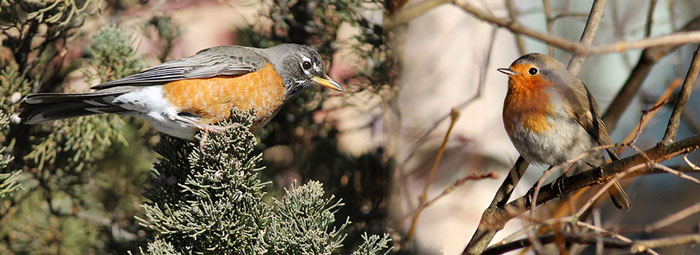ROBIN
Just a word about the American robin and the differences between it and the subject of these pages, the British or European redbreast. Though folks in the US and Canada are familiar with a bird they have named ‘robin’ for centuries now, it is in fact a different species (Turdus migratorius) to the British robin (Erithacus rubecula). Our American cousins have different behaviours, also, and an entirely different appearance and song.
Same applies to Australian robins. There are several birds Down Under with the term 'robin' included in their names. It’s due to European settlers in the past who, when they first began to inhabit places overseas, tended to apply the name of 'robin' to the first bird they saw with a red breast. It was a perfectly forgivable combination of fondness and nostalgia for the wildlife back home, but was made without being aware of the proper classification of species that we enjoy today.

The American robin (left) and European robin (right)
The American robin is a member of the thrush family, and is around twice the size of the British one. Also, because it migrates during winter, the American bird is considered a welcome sign of spring when it returns from its travels. But over here, the majority of British robins stay put in winter, on their home turf, with just a few exceptions – mostly females - who just occasionally elect to go away to warmer climes during the harshest days of the British winter. The majority that remain are conspicuous winter birds, therefore, and this is partly why you see us so frequently depicted on Christmas cards here in the UK.
So, if you are visiting this site from the US or Canada, please don’t take the information provided here as being applicable to your bird. It isn’t. They are all lovely, of course - all robins - but this website is all about the ones that are seen in the British garden.